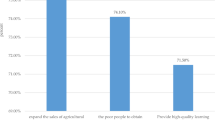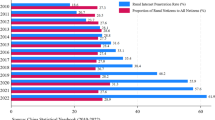Abstract
Over time, most of the farm households lack the good access of internet and mobile phone; thereby, the use causes a problem with the disparities observed between farm households located in urban and rural areas, which could increase their poverty in Niger. This paper estimates the causal effect of the internet and mobile phone’s use by the Nigerien’s farm household on their poverty. To do so, the propensity score matching (PSM) estimation’s method is used on cross-sectional data collected from 4000 households in 2014. The results revealed that the intensity and severity of poverty decrease for the rural Nigerien’s farm household that uses the mobile phone. Also, the farm household’s income level like the total expenses and money transfer received determines their internet and mobile phone’s use, but the farm households in rural areas are negatively and significantly affected by the internet and mobile phone’s use. An emphasis should be placed on the mobile phone’s use by the farm household in rural areas to reduce poverty in Niger.
Similar content being viewed by others
Notes
Results can be provided on request.
Results can be provided on request.
References
Aker, J.C. 2008. Does digital divide or provide ? The impact of cell phones on grain markets in Niger. Working paper no. 154, Center for Global Development, 64 p.
Aker, J.C. 2010. Information from markets near and far: Mobile phones and agricultural markets in Niger. American Economic Journal: Applied Economics 3: 46–59. https://doi.org/10.1257/app.2.3.46.
Aker, J.C., and I.M. Mbiti. 2010. Mobile phones and economic development in Africa. Journal of Economic Perspectives 3: 207–232. https://doi.org/10.1257/jep.24.3.207.
Arifin, Z. 2004. The impact of mobile phones on household welfare in Indonesia: Evidence and implications, 62. Pittsburgh: University of Pittsburgh.
Bedi, A.S. 1999. The role of information and communication technologies in economic development: A partial survey. ZEF—Discussion papers on development policy, vol 7, 45 p. https://doi.org/10.2139/ssrn.3318589.
Bertschek, I., W. Briglauer, K. HHschelrath, and T. Niebel. 2016. The economic impacts of telecommunications networks and broadband internet: A survey. ZEW—Centre for European Economic Research Discussion Paper no 16-056, 51 p. https://doi.org/10.2139/ssrn.2828085.
Brynjolfsson, E., and S. Yang. 1996. Information technology and productivity: A review of the literature. In Advances in computers, 179–214. Amsterdam: Elsevier.
Caliendo, M., and S. Kopeinig. 2008. Some practical guidance for the implementation of propensity score matching. Journal of Economic Surveys 22: 31–72. https://doi.org/10.1111/j.1467-6419.2007.00527.x.
Cecchini, S., and C. Scott. 2003. Can information and communications technology applications contribute to poverty reduction? Lessons from rural India. Information Technology for Development 10: 73–84. https://doi.org/10.1002/itdj.1590100203.
Dehejia, R.H., and S. Wahba. 2002. Propensity Score Matching methods for non-experimental causal studies. The Review of Economics and Statistics 84: 151–161. https://doi.org/10.1162/003465302317331982.
FAO. 2017. The future of food and agriculture: Trends and challenges, 180. Rome: Food and Agriculture Organization of the United Nations.
FAO. 2019. Technologies numériques dans le secteur agricole et dans les zones rurales en brève, 26. Rome: Organisation des Nations Unies pour l’Alimentation et l’Agriculture.
Foster, J., J. Greer, and E. Thorbecke. 1984. A class of decomposable poverty measures. Econometrica 52: 761. https://doi.org/10.2307/1913475.
GSMA. 2018. Enabling rural coverage: Regulatory and policy recommendations to foster mobile broadband coverage in develo** countries, 42 p.
GSMA. 2019. The mobile economy, 34 p.
GSMA. 2020. The mobile economy, 62 p.
INS. 2014. Enquête nationale sur les conditions de vie des ménages et l’agriculture de 2014. ECVM/A-2014, 120. Niamey, Niger: Manuel de l’agent enquêteur, Institut National de la Statistique.
INS. 2019. Évaluation nationale de la situation nutritionnelle par la méthodologie SMART, 180. Niamey, Niger: Institut National de la Statistique.
ITU. 2016. Measuring the information society report, 274. Geneva: International Telecommunication Union, ITU.
May, J.D. 2010. Digital and other poverties: Exploring the connection in four East African countries. Information Technologies and International Development 8: 33–50.
McKinsey & Company. 2014. Offline and falling behind: Barriers to Internet adoption. Technology, Media, and Telecom Practice, 127 p.
Nations Unies. 2015. Les Objectifs de Développement Durable. 70ème session de l’Assemblée Générale des Nations Unies, New York, Transformer notre monde: le Programme de développement durable à l’horizon 2030, 38 p.
Nations Unies. 2018. Livre de poche des statistiques mondiales. Série V, vol. 42, 2018th ed., 293. New York: Nations Unies.
Nations Unies. 2020. Rapport sur les objectifs de développement durable, 68. New York: Nations Unies.
Oliner, S.D., D.E. Sichel, J.E. Triplett, and R.J. Gordon. 1994. Computers and output growth revisited: How big is the puzzle? Brookings Papers on Economic Activity 2: 273–334. https://doi.org/10.2307/2534658.
PNUD. 1997. Rapport mondial sur le développement humain, 280. Paris: PNUD.
Pohjola, M. 2001. Information technology, productivity, and economic growth : International evidence and implications for economic development, 302. Oxford: Oxford University Press.
Qiang, C.Z.-W., and A. Pitt. 2003. Contribution of information and communication technologies to growth. World Bank Working Papers no. 24, 40 p. https://doi.org/10.1596/0-8213-5722.
Rahayu, B.I., and R. Riyanto. 2020. The role of mobile phone and internet use in the performance of rural non-farm enterprises: An analysis of Indonesian rural households. Buletin Pos dan Telekomunikasi 18: 29. https://doi.org/10.17933/bpostel.2020.180103.
Rosenbaum, P.R., and D.B. Rubin. 1983. The central role of the propensity score in observational studies for causal effects. Biometrika 70 (1): 41.
Slater, D., and J. Tacchi. 2004. Research: ICT innovations for poverty reduction. New Delhi: UNESCO.
Solow, R.M. 1987. We’d better watch out. New York Times Book Review, July 12, 2 p.
Tankari, M.R. 2018. Mobile phone and households’ poverty: Evidence from Niger. Journal of Economic Development 43: 67–84. https://doi.org/10.35866/CAUJED.2018.43.2.004.
Waverman, L., M. Meschi, and M. Fuss. 2005. The impact of telecoms on economic growth in develo** countries. The Vodafone Policy Paper Series 2: 10–24.
World Bank. 2001. World Development Report 2000–2001: Attacking poverty, 356. Washington D.C: Oxford University Press, Inc., World Bank.
World Bank. 2013. Agricultural sector risk assessment in Niger: Moving from crisis response to long-term risk management. Technical assistance, Washington D.C., 90 p.
World Bank Group. 2016. World development report 2016: Digital dividends, 58. Washington, DC: World Bank Group.
Author information
Authors and Affiliations
Corresponding author
Additional information
Publisher's Note
Springer Nature remains neutral with regard to jurisdictional claims in published maps and institutional affiliations.
Rights and permissions
Springer Nature or its licensor (e.g. a society or other partner) holds exclusive rights to this article under a publishing agreement with the author(s) or other rightsholder(s); author self-archiving of the accepted manuscript version of this article is solely governed by the terms of such publishing agreement and applicable law.
About this article
Cite this article
Djibo, O., Malam, M.N. The Digital Divide and Poverty in Develo** Countries: Evidence from Farm Households in Niger. J. Quant. Econ. (2024). https://doi.org/10.1007/s40953-024-00401-1
Accepted:
Published:
DOI: https://doi.org/10.1007/s40953-024-00401-1




